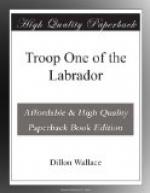Buckskin moccasins with heavy blanket duffle socks of wool took the place of sealskin boots. The dry snow would not again soften to wet them until spring. The adiky, with its fur-trimmed hood, took the place of the jacket, soon to be augmented by sealskin netseks or caribou skin kulutuks.
“The Bay’s smokin’,” David announced one evening as he came in after feeding the dogs. “She’ll soon freeze now.”
In the days that followed the smoke haze hung over the water until, one morning, the Bay was fast, and the lapping of the waves was not to be heard again for many months.
The nine sledge dogs were in fine fettle. Handsome, big fellows they were, but fearsome and treacherous enough. They looked like sleek, fat wolves, and they were, indeed, but domesticated wolves. Friendly they seemed, but they were ever ready to take advantage of the helpless and unwary, and their great white fangs were not above tearing their own master into shreds should he ever be so careless as to stumble and fall among them.
The sledge was taken out and overhauled by David. It was fourteen feet long and two and a half feet wide. Twenty cross-bars formed the top. Not a nail was used in its construction, for nails would not hold an hour on rough ice. Everything was bound with sealskin thongs. The sledge shoes were of iron. These David polished bright with sand, and then applied a coating of seal oil. Finally the harness and long sealskin traces were examined, and all was ready.
It was the end of November when the Bay froze, but there was no certainty that travelling would be safe upon the sea ice beyond Fort Pelican before the beginning of January. Therefore Doctor Joe confined his visits to the Bay folk during December, and on his first tour Andy served as driver with Jamie as passenger.
The dogs were harnessed after the Eskimo fashion. That is to say, “fan shape,” and not, as is customary in Alaska and among white men of the far northwest, in tandem.
Leading from the komatik (sledge) in front was a single thong of sealskin with a loop on its end. This was called the “bridle.” Each dog had an individual trace, its end passed through the loop in the bridle and securely tied. Tinker, the leading dog, was fully thirty-five feet from the komatik when his trace was stretched to its full length. He had the longest trace of all. He was trained to respond to shouted directions, turning to the right when “ouk” was called, or left for “rudder,” the word being repeated several times by the driver in rapid succession. When it was desired that the dogs should stop, “ah” was the order, and when they were to go forward “ooisht,” or “oksuit.” The other dogs followed Tinker as a pack of wolves follows the leader. The two dogs directly behind Tinker had traces of equal length, but somewhat shorter, the pair behind them still shorter, and so on to the last pair.
A long whip was used to keep them in subjection. This was of braided walrus hide an inch thick at its butt and tapering to a thin lash. To the butt was attached a short wooden handle a foot in length, to which was fastened a loop which was hooked over the protruding end of the forward cross-bar and the whip permitted to trail upon the ice when not in use, and at the same time it was always within the driver’s reach.




